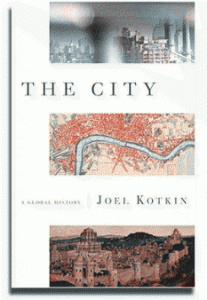By Joel Kotkin

Modern Library
Purchase at:
Foreign editions available in Portuguese, Chinese (Social Science Press), and Spanish (Debate Press) as well as from Orion Books in the United Kingdom. Japanese and Korean editions are also available.
Cities are the fulcrum of civilization. In this short, authoritative yet winningly informal account, urbanist Joel Kotkin examines the evolution of cities and urban life over thousands of years. He begins with the religious roots of urbanism in Mesopotamia, the Indus Valley, and China, and takes us to emergence of the Classical City; Byzantium and the cities of the Middle East; the rise of Venice and subsequent commercial city-empires; the industrial city (from London to Shanghai to Detroit); and on to the post-industrial, suburban realities of today. He concludes with a shrewd diagnosis of the problems and crises facing cities in the 21st-Century.
Unlike other books on cities, Kotkin’s is truly global in scope (even Lewis Mumford confined his vision to the West). For Kotkin, cities are not merely “machines for living” but embodiments of the highest ideals: how we can live, cooperate and create together. In looking at the history of city life as a continuous whole, THE CITY is nothing less than a breathtaking account of the human achievement itself.
